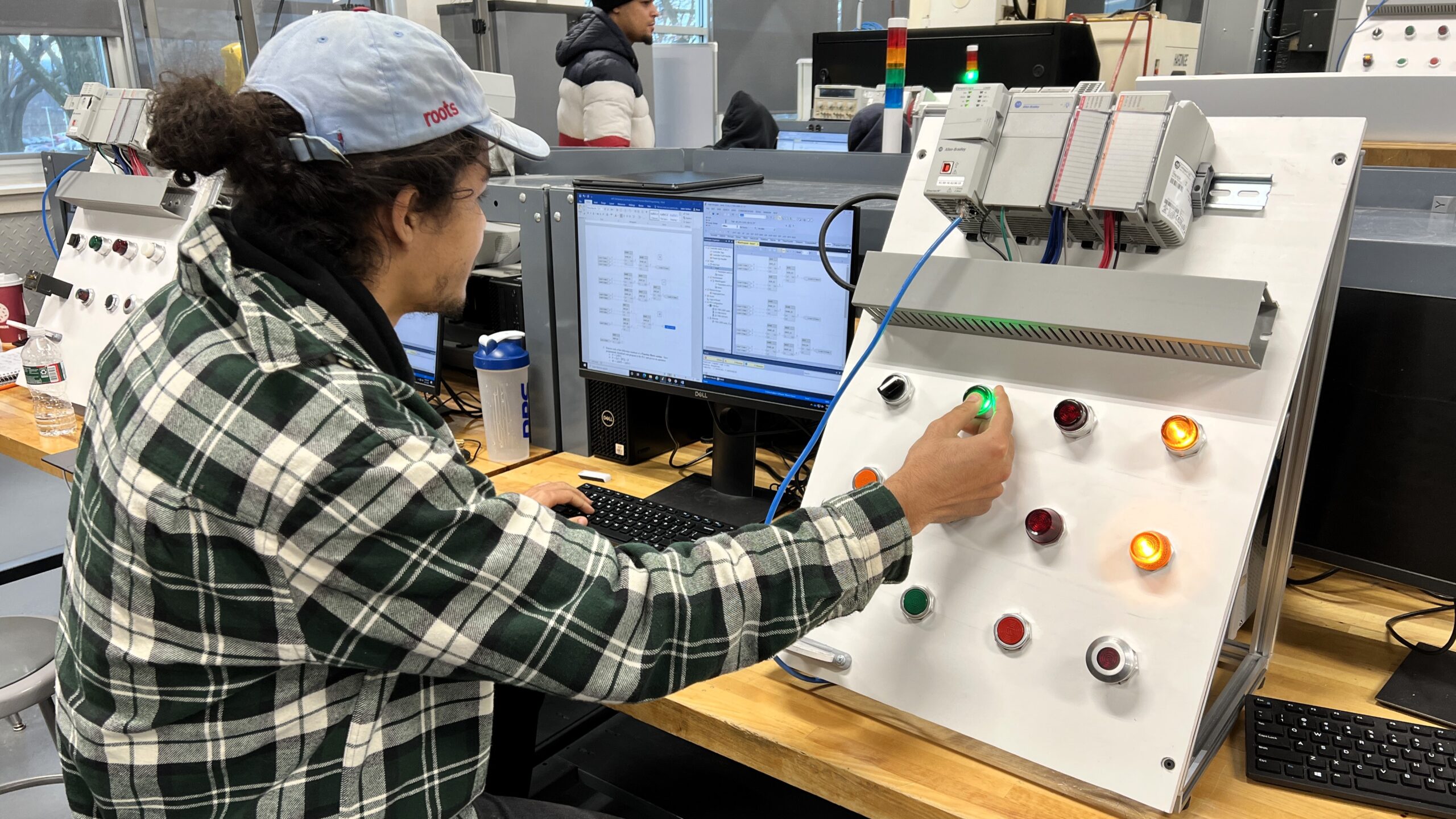Electronic Engineering Technology
Program Overview

The two-year Electronic Engineering Technology Associate Degree program prepares graduates as entry-level technicians. Students will become proficient in the theoretical and practical applications associated with electronic devices, instrumentation controls, and systems.
We use RoboDK for simulation and offline programming of industrial robots.
Watch the video below to learn why Electronic Engineering Technology might be right for you.
Career Opportunities
Graduates work as technicians and sales representatives in the field of electronic instrumentation and computer repair. Typical employers in the electronic career are machine, tool, and instrumentation manufacturers; electronic service companies; communication industries; electronic media; and electronic sales.
Our Electronic Engineering Technology program graduates enter the region’s workforce at locations such as Jam Works, LLC in Mayfield, PA, Lockheed Martin in Archbald, PA, and Tobyhanna Army Depot in Tobyhanna, PA.
Program Learning Goals
Goal 1: Graduates will be able to troubleshoot electronic circuits and systems using theoretical principles and measured values to resolve operational issues.
Student Learning Outcomes – Students will:
- Demonstrate competence with circuit identification
- Demonstrate competence in using various pieces of test equipment to gather information about a circuit or systems operation
- Employ corrective actions to make repair to systems under test
Goal 2: Graduates will demonstrate the ability to communicate with a customer, team member or supervisor in a professional manner to determine the nature of a problem or to explain repairs.
Student Learning Outcomes – Students will:
- Explain the defect found in circuits or systems and the solution to rectify the problem
- Produce written reports outlining work performed
Goal 3: Graduates will be able to use hand tools and test equipment in a safe manner.
Student Learning Outcomes – Students will:
- Demonstrate the safe use of a multimeter while making measurements in live circuits
- Demonstrate the safe use of oscilloscopes and other lab equipment to make measurements or apply signals.
Course Outline
2025-2026 Program Sequence
| Term 1 (Fall) | Credits: 16 | |
| ART-127 | Computer Aided Design | 3 |
| EET-101 | Introduction to Electronic Equipment | 1 |
| EET-161 | DC Electricity and Instrumentation | 2 |
| EET-162 | DC Electricity and Instrumentation Lab | 1 |
| EET-163 | Alternating Current and Passive Devices | 2 |
| EET-164 | Alternating Current and Passive Devices Lab | 1 |
| MAT-101 | College Algebra and Trigonometry | 3 |
| MEC-103 | Project Management | 2 |
| SSS-101 | First Year Experience | 1 |
| Term 2 (Spring) | Credits: 19 | |
| EET-165 | Digital Electronics | 2 |
| EET-166 | Digital Electronics Lab | 2 |
| EET-167 | Introduction to Semiconductors | 2 |
| EET-168 | Introduction to Semiconductors Lab | 1 |
| EET-169 | Integrated Circuits and Thyristors | 2 |
| EET-170 | Integrated Circuits and Thyristors Lab | 1 |
| HUM Elective | Humanities Elective | 3 |
| MAT-201 | College Algebra II and Trigonometry | 3 |
| MEC-157 | Sensors and Systems in Automation | 2 |
| MEC-158 | Sensors and Systems in Automation Lab | 1 |
| Term 3 (Fall) | Credits: 17 | |
| BUS-101 | Introduction to Business | 3 |
| COM-112 | Public Speaking | 3 |
| EET-261 | Communication Electronics | 2 |
| EET-262 | Communication Electronics Lab | 1 |
| MEC-243 | Automation and Robotics I | 2 |
| MEC-244 | Automation and Robotics I Lab | 2 |
| MEC-245 | Programmable Logic Controllers I | 2 |
| MEC-246 | Programmable Logic Controllers I Lab | 2 |
| Term 4 (Spring) | Credits: 18 | |
| CIT-183 | Network Architectures, Principles, and Protocols | 2 |
| CIT-184 | Network Architectures, Principles, and Protocols Lab | 1 |
| EET-265/266 | Applied Electronics Principles and Applications/Lab | 4 |
| OR INT-299D | OR Internship | |
| MEC-155 | Additive Manufacturing | 1 |
| MEC-156 | Additive Manufacturing Lab | 2 |
| MEC-253 | Automation and Robotics II | 2 |
| MEC-254 | Automation and Robotics II Lab | 2 |
| MEC-255 | Programmable Logic Controllers II | 2 |
| MEC-256 | Programmable Logic Controllers II Lab | 2 |
| EET Program Total | 70 |
This term layout is based off of a fall start. Students who start in the spring will be required to attend an additional term to complete their degree.
There may be special admission requirements for this program. Please speak with a Recruitment Advisor by calling 570-702-8856 or email enroll@johnson.edu to review our requirements.
For course descriptions, please visit the Course Catalog.


